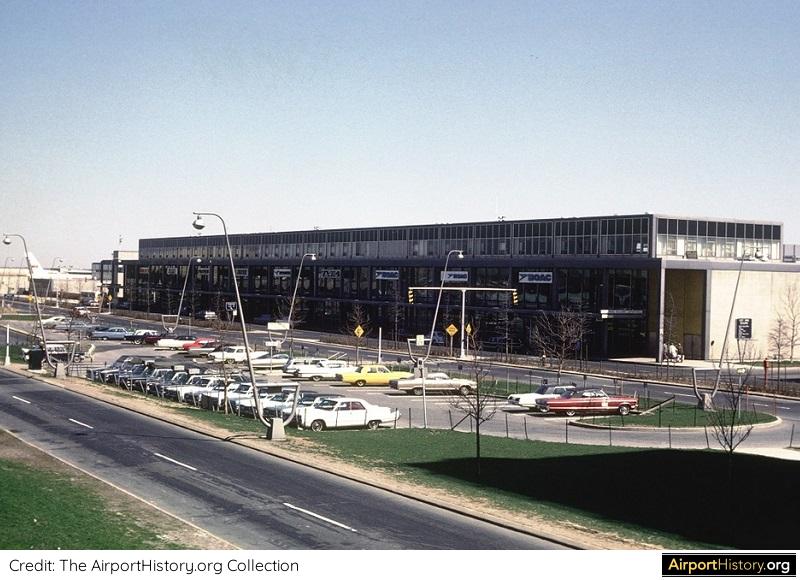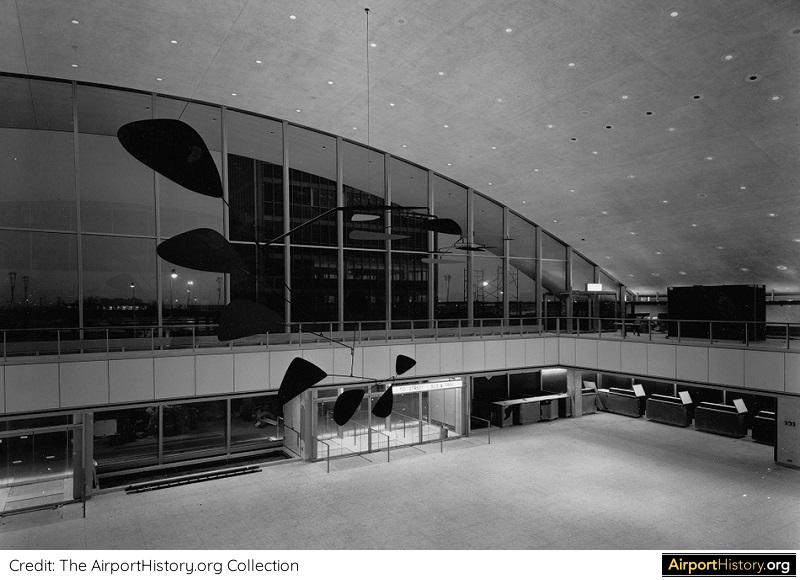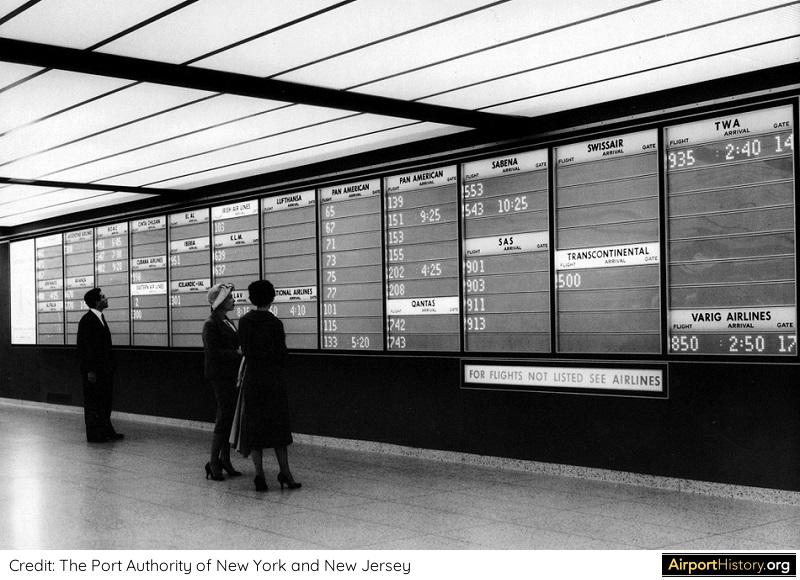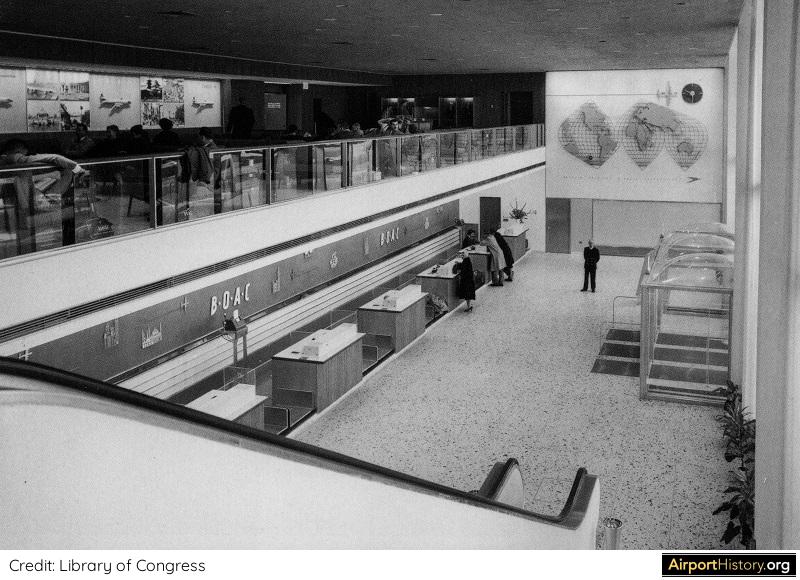Published: March 21, 2019
Updated: January 2, 2021
Updated: January 2, 2021
In this third installment of our multi-part history on New York John F. Kennedy Airport, we'll take a tour of the airport's first permanent passenger terminal building, the International Arrivals Building (IAB).
The International Arrivals Building and Wing Buildings (1957)
THE HEART OF TERMINAL CITY
Stretching for eleven city blocks and containing nearly 600,000 square feet (55,742 square meters), the first permanent passenger terminal at Kennedy Airport was an elegant composition of three linked buildings with the central U-shaped International Arrival Building (IAB), which was flanked by two Airline Wing Buildings.
Designed by Skidmore, Owings and Merril (SOM), this was the civic center of Terminal City. The parabolic arch of the arrival hall and the control tower became the airport's logo. The entire complex provided a total of 24 aircraft stands.
Stretching for eleven city blocks and containing nearly 600,000 square feet (55,742 square meters), the first permanent passenger terminal at Kennedy Airport was an elegant composition of three linked buildings with the central U-shaped International Arrival Building (IAB), which was flanked by two Airline Wing Buildings.
Designed by Skidmore, Owings and Merril (SOM), this was the civic center of Terminal City. The parabolic arch of the arrival hall and the control tower became the airport's logo. The entire complex provided a total of 24 aircraft stands.
THE IAB
The IAB housed all Customs, Health and Immigration services and was originally used by all arriving flights requiring customs and immigration clearance. A key innovation in the design of the customs halls was the introduction of a supermarket-style clearance process whereby passengers claimed their luggage from racks and then proceeded to any of the 32 check-outs arranged in 16 pairs.
Here, conveyor belts moved the bags along for inspection by the customs officers and cash registers were installed to collect any duty payable. In the IAB's early days, the whole international arrival process from aircraft door to the public arrival hall could take as little as 15 minutes, compared to an hour in the temporary terminal.
The IAB also contained The Golden Door Restaurant and Cocktail Lounge, a coffee shop, a barber shop, a bookstore, a florist shop, a jewelry store and multiple waiting rooms.
The IAB housed all Customs, Health and Immigration services and was originally used by all arriving flights requiring customs and immigration clearance. A key innovation in the design of the customs halls was the introduction of a supermarket-style clearance process whereby passengers claimed their luggage from racks and then proceeded to any of the 32 check-outs arranged in 16 pairs.
Here, conveyor belts moved the bags along for inspection by the customs officers and cash registers were installed to collect any duty payable. In the IAB's early days, the whole international arrival process from aircraft door to the public arrival hall could take as little as 15 minutes, compared to an hour in the temporary terminal.
The IAB also contained The Golden Door Restaurant and Cocktail Lounge, a coffee shop, a barber shop, a bookstore, a florist shop, a jewelry store and multiple waiting rooms.
THE WING BUILDINGS
Joining the International Arrival Building at each end were the Airline Wing Buildings. The Wing Buildings housed ticket counters, lobbies and offices for the more than 20 foreign flag airlines using the airport. Each of the carrier's blocks had an attractive custom designed interior layout.
There was no common departure area for departing passengers. After checking in on the ground floor, passengers proceeded to a second-story waiting room. When the flight was announced, passengers would proceed to the adjoining gate.
Joining the International Arrival Building at each end were the Airline Wing Buildings. The Wing Buildings housed ticket counters, lobbies and offices for the more than 20 foreign flag airlines using the airport. Each of the carrier's blocks had an attractive custom designed interior layout.
There was no common departure area for departing passengers. After checking in on the ground floor, passengers proceeded to a second-story waiting room. When the flight was announced, passengers would proceed to the adjoining gate.
GALLERY: INTERNATIONAL ARRIVALS BUILDING (IAB) - AERIAL AND EXTERIOR VIEWS
Enjoying this article?
Sign up to our e-mail newsletter to know when new content goes online!
CATERING TO THE ENTHUSIAST
The entire length of the IAB and Wing Buildings contained a 4,000-foot-long (1,220-meter) observation deck where visitors could listen in to the conversations between control tower and aircraft by means of coin-operated radios.
An elevated promenade connected the building with the public parking areas and the control tower, which had a tenth-floor observation deck.
Having cost USD 30 million, the IAB and Wings were dedicated on December 5th, 1957, and operations started in the early hours of the next day. The honors for the first arrival went to a B.O.A.C. Douglas DC-7 from Nassau, while the first transatlantic arrival was a Pan American Boeing Stratocruiser from London. The IAB and Wing Buildings were later renamed Terminal 4.
The entire length of the IAB and Wing Buildings contained a 4,000-foot-long (1,220-meter) observation deck where visitors could listen in to the conversations between control tower and aircraft by means of coin-operated radios.
An elevated promenade connected the building with the public parking areas and the control tower, which had a tenth-floor observation deck.
Having cost USD 30 million, the IAB and Wings were dedicated on December 5th, 1957, and operations started in the early hours of the next day. The honors for the first arrival went to a B.O.A.C. Douglas DC-7 from Nassau, while the first transatlantic arrival was a Pan American Boeing Stratocruiser from London. The IAB and Wing Buildings were later renamed Terminal 4.
GALLERY: INTERNATIONAL ARRIVALS BUILDING (IAB) - INTERIOR VIEWS
Later on, we will revisit the IAB during its late 1960s expansion. We have merely set the stage. Click below to read the next part, where we will explore how Idlewild dealt with the advent of the Jet Age!
Do you have memories of Idlewild in in the early years? Share them below!
Do you have memories of Idlewild in in the early years? Share them below!



















